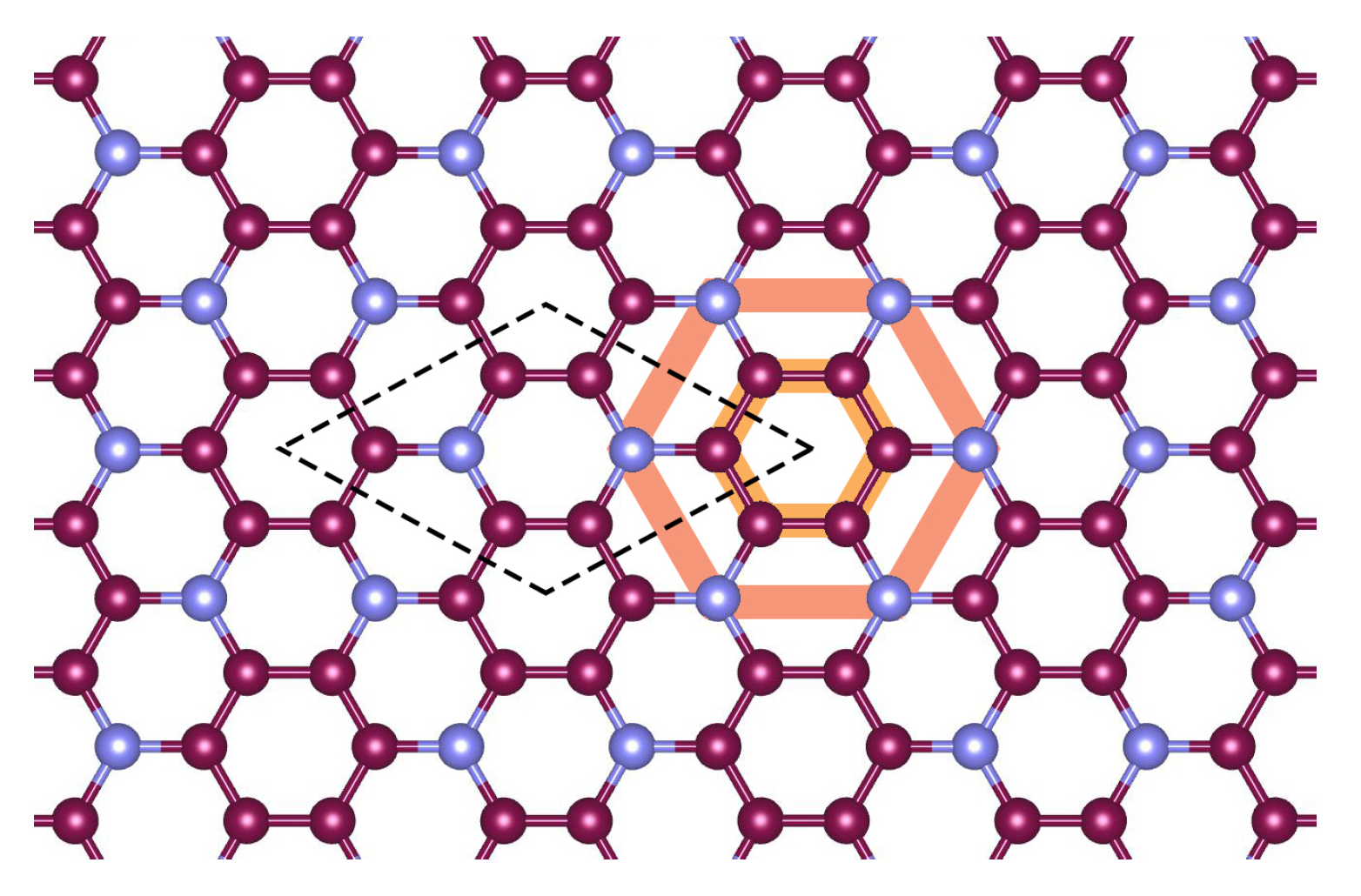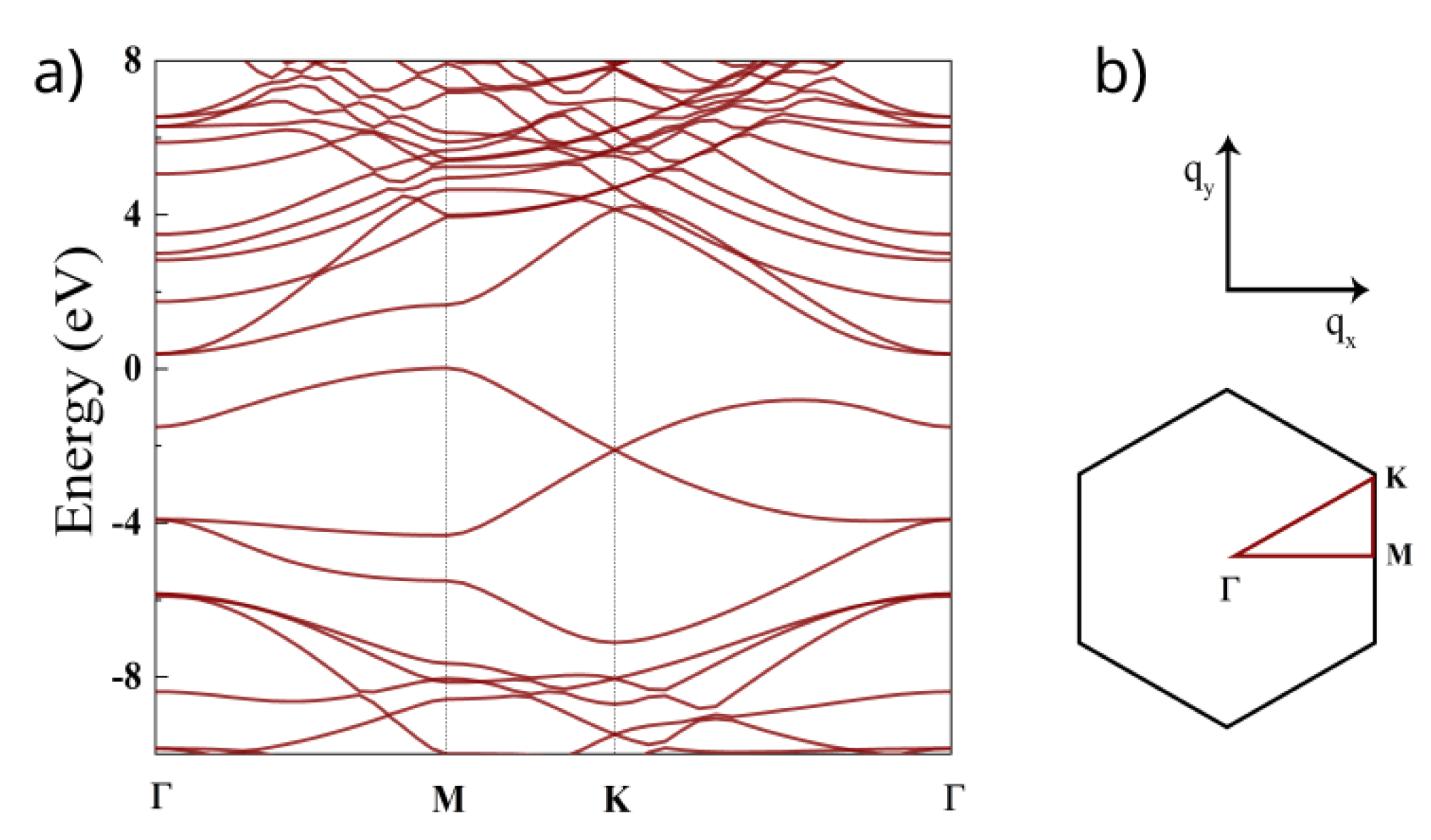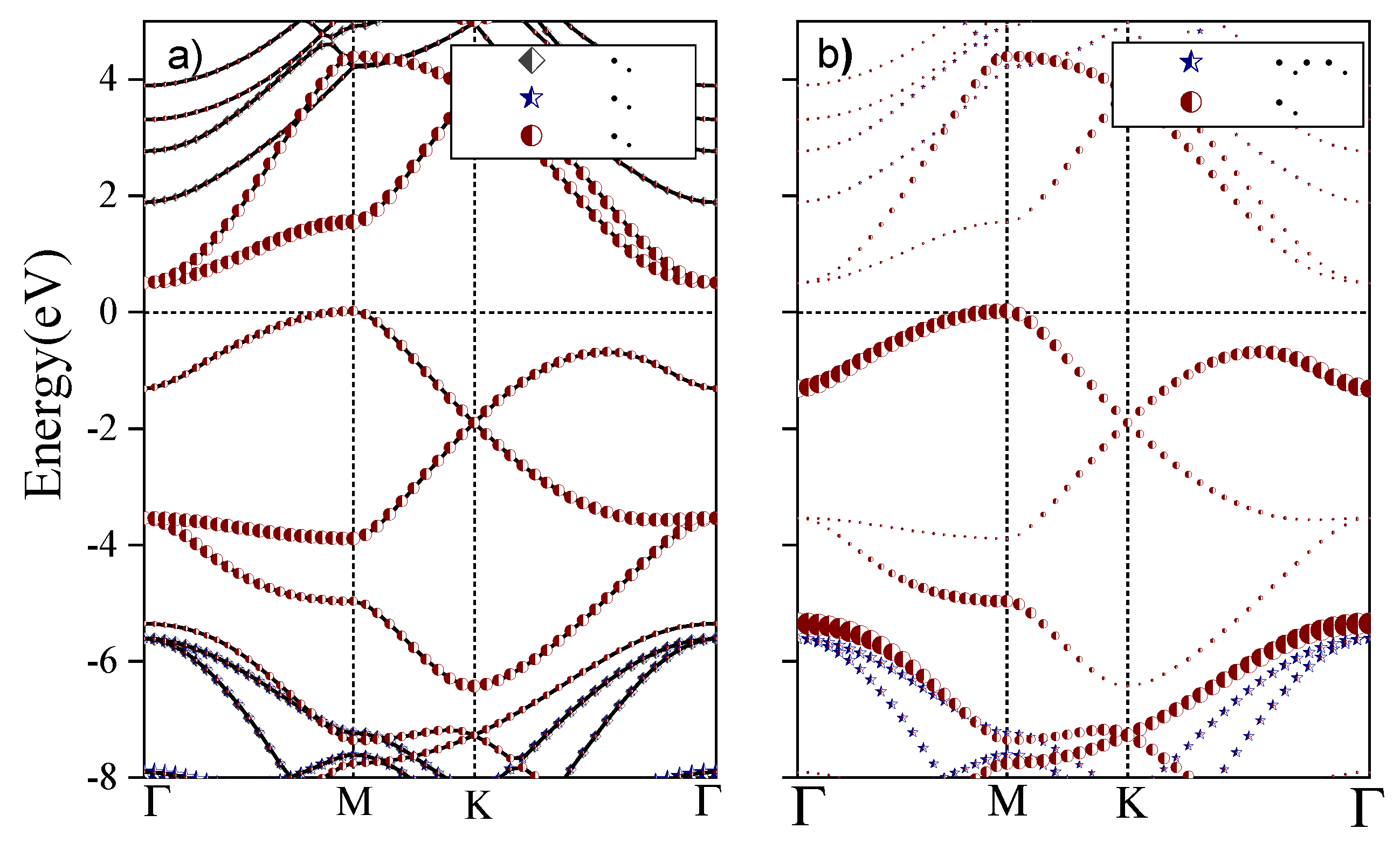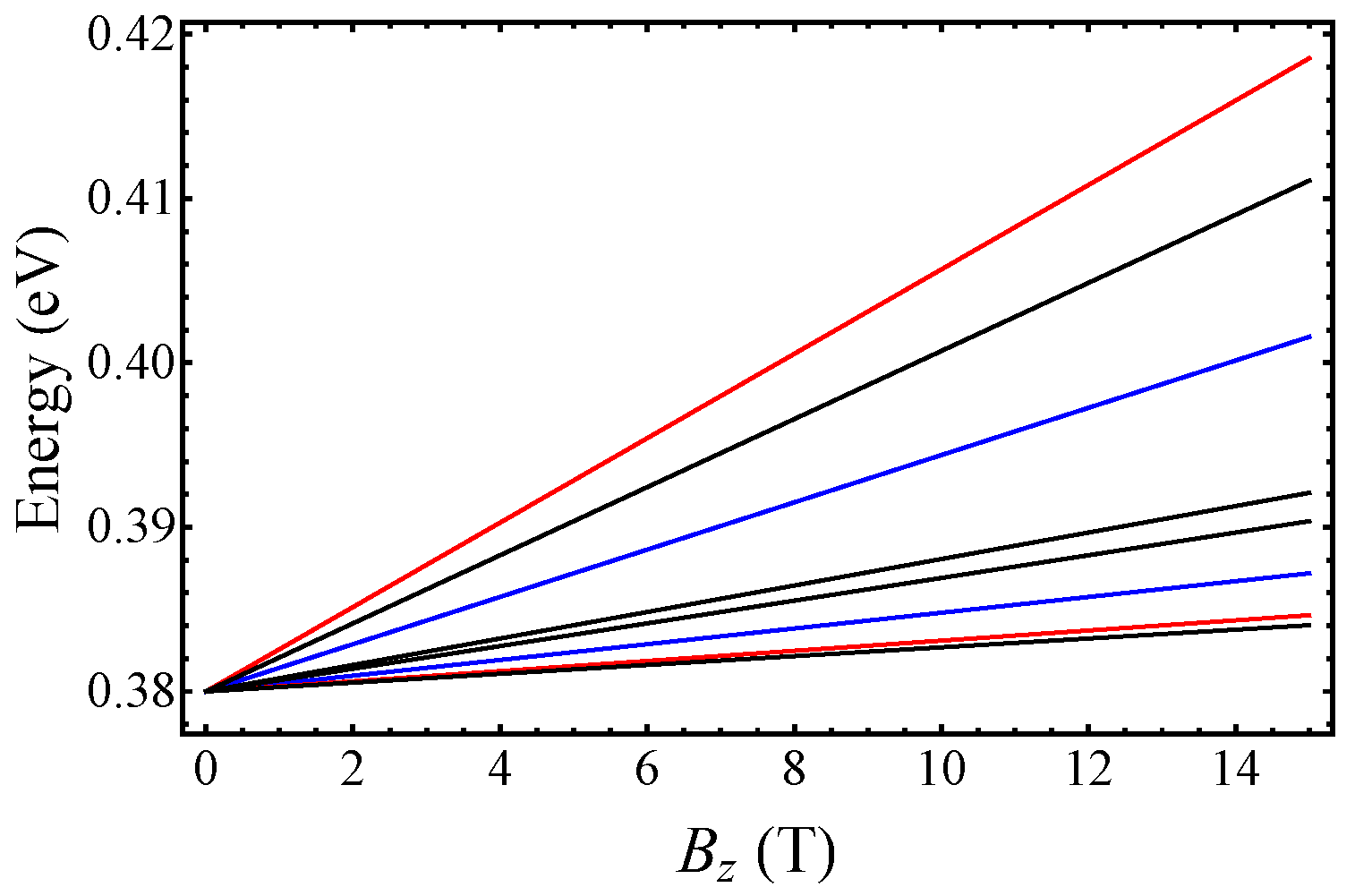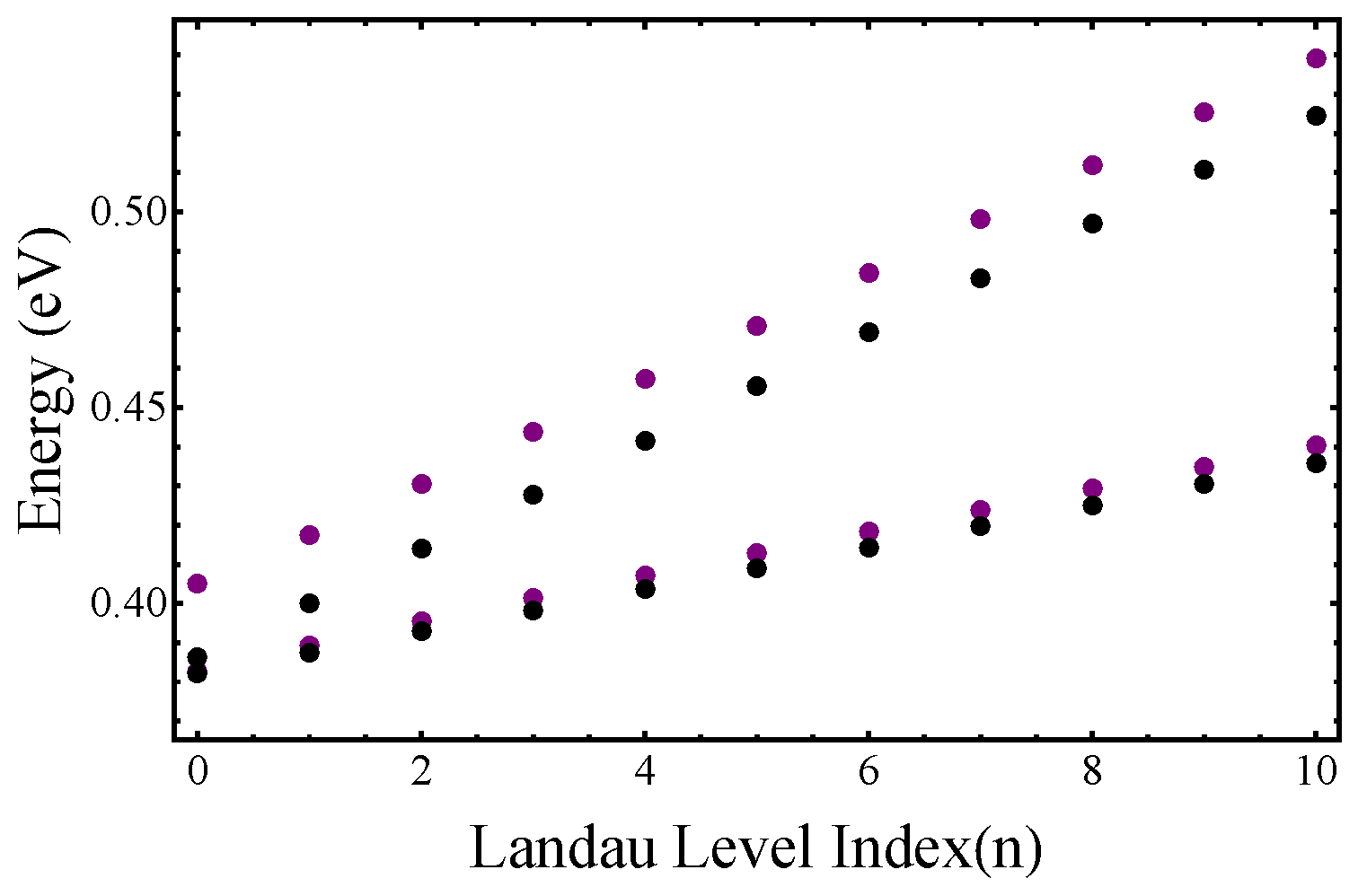1. Introduction
Graphene [
1] has received a great deal of attention due to its unique mechanical, electronic, thermal and optoelectronic properties [
2,
3,
4]. However, having a zero band gap limited the applications of graphene in electronic nano-devices and motivated the search for atomically thin two-dimensional (2D) materials, which have a finite band gap. This led to the discovery of, for example, monolayer transition metal dichalcogenides [
5,
6,
7], silicene [
8,
9], phosphorene [
10,
11], and germanene [
12]. In recent years, compounds of carbon nitrides
have also become attractive 2D materials [
13,
14,
15]. For example, graphitic carbon-nitride (g-
), which is a direct band gap semiconductor, has potential applications in photocatalysis and in solar energy conversion due to its strong optical absorption at visible frequencies [
16,
17]. Another carbon-nitride compound, two-dimensional crystalline
N, has also been recently synthesized [
18,
19].
N is an indirect band gap semiconductor with an energy gap of
eV [
19]. Moreover, it has shown favorable properties, such as high mechanical stiffness [
20] and interesting excitonic effects [
21,
22]. In addition, its thermal conductivity properties have been investigated [
20,
23,
24], and it has been predicted that the electronic, optical and thermal properties of monolayer
N can be tuned by strain engineering [
25,
26].
In this work, we employ the
[
27,
28] approach in order to study the electronic properties of monolayer
N. We obtain the materials specific parameters appearing in the
model from fitting it to density functional theory (DFT) band structure calculations. A similar methodology has been successfully used, e.g., for monolayers of transition metal dichalcogenides [
29,
30]. In particular, since the conduction band (CB) minimum and valence band (VB) maximum are located at the
and
M points of the Brillouin zone, respectively, we obtain
Hamiltonians valid in the vicinity of these points. The insight given by the
model allows us to comment on certain optical properties as well. Moreover, we will also study the Landau-level spectrum of
N, which, to our knowledge, has not been considered before.
This paper is organized as follows. In
Section 2, we start with a short recap of the band structure obtained with the help of the density functional theory calculations. In
Section 3, effective
Hamiltonians at
and
M points are obtained, using symmetry groups and perturbation theory. Certain optical properties of this material are discussed in
Section 4. In
Section 5, the spectra of Landau levels for this material are calculated at the
and
M points. Finally, our main results are summarized in
Section 6.
2. Band Structure Calculations
The band structure of monolayer
N has been calculated before at the DFT level of theory [
25,
31,
32] and also using the GW approach [
21,
22,
33]. The main effect of the GW approach is to enhance the band gap, and this does not affect our main conclusions below. To be self-contained, we repeat the band structure calculations at the DFT level. The schematics of the crystal lattice of single-layer
N is shown in
Figure 1. The lattice of
N possesses P6/mmm space group with a planar hexagonal lattice, and the unit cell contains six carbon and two nitrogen atoms. We used the Wien2K package [
34] to perform first-principles calculations based on density functional theory (DFT). For the exchange–correlation potential, we used the generalized gradient approximation [
35]. The optimized input parameters, such as RKmax, lmax, and k-point, were selected to be
, 10, and
, respectively. The convergence accuracy of self-consistent calculations for the electron charge up to
was chosen, and the forces acting on the atoms were optimized to
dyn/a.u. The optimized lattice constant is
, in good agreement with previous studies [
31,
36].
The calculated band structure is shown in
Figure 2. The conduction band minimum is located at the
point, while the valence band maximum can be found at the
M of the BZ. Thus, at the DFT level,
N is an indirect band gap semiconductor with a band gap of
eV which is in good agreement with previous works [
19,
37]. We checked that the magnitude of the spin-orbit coupling is small at the band-edge points of interest and, therefore, in the following, we will neglect it. The main effect of spin-orbit coupling is to lift degeneracies at certain high-symmetry points and lines, e.g., the four-fold degeneracy of the conduction band at the
point would be split into two, two-fold degenerate bands.
4. Comments on the Optical Properties
Recently, Refs. [
21,
22] studied the optical properties of
N based on the DFT+
methodology to obtain an improved value for the band gap and the Bethe-Salpeter approach to calculate the excitonic properties. Several findings of Refs. [
21,
22] can be interpreted with the help of the results presented in
Section 3.
According to the numerical calculations of Ref. [
22], the lowest energy direct excitonic state is doubly degenerate and dark. The corresponding electron-hole transitions are located in the vicinity of the
point, and the electron part of the exciton wavefunction is localized on the benzene rings of
N if the hole is fixed on an N atom.
Firstly, we note that there is no
matrix element between the VB and the doubly degenerate CB at the
point (see
Appendix A), which indicates that direct optical transitions are forbidden by symmetry. Furthermore, as shown in
Figure 3, at the
point, the
atomic orbitals of the C atoms have a large weight in the CB, CB+1 bands, and the same applies to the
atomic orbitals of the N atoms in the VB. According to
Table A2, the degenerate CB, CB+1 bands correspond to the two-dimensional
irreducible representation of
. One can check that the following linear combinations of the
atomic orbitals of the C atoms transform as the partners of the
irreducible representation:
where
, and
,
denote the
orbitals of the six-carbon atoms in the unit cell; see
Figure 1. Bloch wavefunctions based on
and
would indeed have a large weight on the benzene rings in each unit cell, and this helps to explain the corresponding finding of Ref. [
22].
On the other hand, the
matrix elements are non-zero between pairs of the degenerate VB-1, VB-2 and CB, CB+1 bands; see
Table A3. This means that optical transitions are allowed by symmetry, and if circularly polarized light is used for excitation, then
and
would excite transitions between different pairs of bands. Some of the higher-energy bright excitonic states found in Ref. [
22] should correspond to this transition.
At the
M point, on the other hand, there is finite matrix element between the VB and the CB—see Equation (
6)—which suggests that optical transitions are allowed by symmetry along the
line. Moreover, one can expect that the optical density of states is large going from
M toward
because the VB and the CB are approximately parallel. Note that the time-reversed states can be found at
, i.e., on the other side of the
point. Therefore, one can expect that in a zero magnetic field, two degenerate bright excitonic states can be excited, and in the
space, they are localized on opposite sides of the
point along the
lines. This corresponds to the findings of Ref. [
22]. In an external magnetic field, which breaks time reversal symmetry, the degeneracy of the two excitonic states would be broken. This is reminiscent of the valley degeneracy breaking for magnetoexcitons in monolayer TMDCs [
43,
44,
45,
46,
47].
The transition along the line can be excited by a linearly polarized light. For a general direction of the linear polarization with respect to the crystal lattice, transitions along all three directions in the BZ would be excited. However, when the polarization of the light is perpendicular to one of the line, then the interband transitions are excited only in the remaining two “valleys”. In contrast, when circularly polarized light is used for excitation, all three “valleys” are excited.
5. Landau Levels
We now consider the Landau-level (LL) spectrum of monolayer
N. Using the
Hamiltonians, one can employ the Kohn–Luttinger prescription; see, for example, Ref. [
39]. This means that one can replace the wavenumber
by the operator
, where
is the magnitude of electron charge, and
is the vector potential describing the magnetic field. We expect that this approach should be accurate for low-energy LLs, which are our main interest here. For high magnetic fields and/or high LL indices,
n more advanced methods may need to be used [
48].
In the following, we will use the Landau gauge and
. Since the components of
do not commute, the Kohn–Luttinger prescription should be performed in the original nine-band (
point) or thirteen-band (
M point)
Hamiltonians (see Appendices
Appendix A and
Appendix B) and not in the low-energy effective ones given in Equations (
1)–(
3) and (
4)–(
6), respectively. After the Kohn–Luttinger prescription in the higher-dimensional
model, one can again use the Löwdin partitioning to obtain low-energy effective Hamiltonians by taking care of the order of the non-commuting operators appearing in the downfolding procedure. This approach was used, for example, in the case of monolayer TMDCs to study the valley-degeneracy breaking effect of the magnetic field [
49].
5.1. Effective Model at the Point
The low-energy model can be expressed in terms of
. Note, that
and
do not commute, so that
, where
is a perpendicular magnetic field:
where
was defined in Equations (
1)–(
3),
is the Zeeman term, and
The operators
in
are defined as follows:
Here,
corresponds to the VB, while the degenerate CB, CB+1 are described by the
block in Equation (
10). One can introduce the creation and annihilation operators
,
a by
,
, where
is the magnetic length. The LLs that are obtained from
correspond to the usual harmonic oscillator spectrum
, where
and
is a positive integer.
Regarding the LLs of the degenerate CB, CB+1 bands, one can anticipate from Equations (
12)–(
14) that the LL spectrum of this minimal model exhibits an interplay of features known from bilayer graphene and conventional semiconductors. Two eigenstates read
where
and
are harmonic oscillator eigenfunctions. The corresponding eigenvalues are
and
, respectively. The eigenstates in Equation (
15) have the same form as the two lowest energy eigenstates of bilayer graphene. However,
and
are not degenerate, and they do depend on a magnetic field, unlike in the case of bilayer graphene.
The rest of the eigenvalues can be obtained by using the Ansatz:
where
and
,
are constants. This Ansatz leads to a
eigenvalue equation yielding the energy of two LLs for each
n. The eigenvalues can be analytically calculated, but the resulting expression is quite lengthy and not particularly insightful.
We plot the first four LLs as a function of the magnetic field in
Figure 4. They correspond to
and
given below in Equation (
15) and the two LLs that can be obtained using the Ansatz in Equation (
16) for
. For comparison, we also plot the energies of “conventional” LLs
and
, where
(
) and the effective mass
(
) was defined below Equation (
1)–(
3). One can see that the LLs calculated using Equations (
15) and (
16) are different from the conventional LLs, which indicates the important effect of the interband coupling. In
Figure 5, we show the LL energies as a function of the LL index
n for a fixed magnetic field
T. One can see that for large
n, the LLs energies obtained from Equation (
16) (magenta dots) run parallel to the conventional LLs (black dots). This means that in this limit, both set of LLs can be described by cyclotron energies
and
, but there is an energy difference between them. However, in the deep quantum regime (
) the two sets of LLs cannot be characterized by the same cyclotron frequencies.
We note, however, that electron–electron interactions may modify the above single particle LL picture, similarly to what has recently been found in monolayer
[
50]. Namely, the obtained effective masses of the degenerate CB and CB+1 bands are quite large, which means that the kinetic energy of the electrons is suppressed. The importance of the electron–electron interactions can be characterized by the dimensionless Wigner–Seitz radius
. Here,
is the electron density,
is the effective Bohr radius,
is the effective mass,
is the dielectric constant and
is the Bohr radius. Taking [
31]
and an electron density of
, one finds
for the heavier band, where
. This value of
indicates that electron–electron interactions can be important. Therefore, this material may offer an interesting system to study the interplay of electron–electron interactions and interband coupling.
5.2. M Point
We obtain the following low-energy effective Hamiltonian in terms of the operators
and
:
where
was defined in Equation (
5) and
corresponds to Equation (
6):
where
The off-diagonal elements of
are significantly smaller than the diagonal ones for magnetic fields
T; therefore, one can again use the Löwdin partitioning to transform them out. Since the band edge at the
M point is in the VB, in the following, we consider the LLs in this band. By rewriting
and
in terms of annihilation and creation operators
, and
, one finds that the LLs for VB are given by
Here
is the cyclotron frequency, where
and
and
refer to the effective masses along the
-
M and
M-
K directions; see
Table 1.
